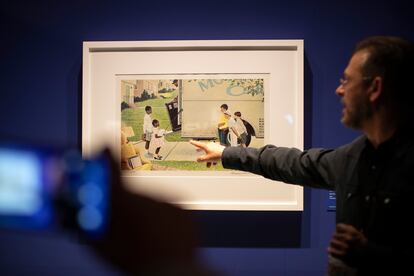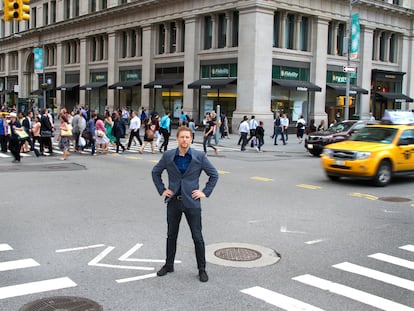‘Suburbia’ exhibition captures the allure and delirium of the American dream
The Center for Contemporary Culture of Barcelona explores the influence of North American middle-class suburbs on artistic and cultural imagination


The American suburb, a blend of urban and rural, is home to half of the U.S. population. It embodies aspirations and contradictions, shaping values and images. A new exhibition at Barcelona’s Center for Contemporary Culture (CCCB) delves into the history and cultural impact of middle-class suburbs from the late 19th century to the present. This exhibition, running until September, traces the evolution of suburbs and their cultural contributions since their inception. Titled Suburbia after Bill Owens’ photojournalism book (1973) on the subject, the exhibition captures the complex reality of the American dream, with all its shades and complexities. Curated by journalist Philipp Engel and directed by Jordi Costa, Suburbia offers profound insights into gender and race dynamics.
The exhibition explores the development of suburbs, starting with rail transportation enabling the creation of the first suburb for the upper class — Brooklyn! Suburban expansion continued with the extension of tramlines, and peaked in the 1950s with widespread car ownership and post-World War II families seeking more space. From a “bourgeois utopia” to “housing democratization” via prefabricated homes, this illustrated history of the American suburbs also sheds light on challenges faced by women as homemakers, and fears of social unrest that led to heavily armed households. The “Disturbia” part of the exhibition spotlights the anxiety of suburban life, while the “Color of Paradise” section looks at the struggles faced by non-white families moving into the suburbs.

The “McMansion Hell” section of the exhibition illustrates the excesses of wealthy homeowners who built extravagant, oversized homes lacking in moderation and harmony. These homes, costing millions and ranging up to 16,000 square feet, are often built without professional input, resulting in kitchens resembling TV sets and living rooms that look more like hotel lobbies. Journalist and architecture critic Kate Wagner coined the term, and vividly describes these opulent dwellings on her McMansion Hell website. The Suburbia exhibit ends with photos of deserted malls, gutted by the rise of online shopping giants like Amazon. Benjamin Grant’s aerial photos show the vast suburban sprawl, including the mega-churches that now dot the landscape.

The exhibition features a wide array of items, ranging from 19th-century paintings to modern sculptures depicting the collapse of the suburban living model. It includes paintings by Sevillian artist Alberto Ortega capturing suburban night scenes in oil. The collection showcases TV series from the 1950s to the present, historical ads promoting homeownership over renting, and vintage lawnmowers, washing machines, blenders, refrigerators and toasters. There’s a Model T Ford and homemaker manuals like the 1869 edition of The American Women’s Home. Also included are various books and magazines, like a Life magazine issue with nuclear attack survival tips on the cover, an interview with filmmaker Todd Solondz focusing on American suburbia, and a 1967 illustration by Norman Rockwell portraying the arrival of Black Americans in the suburbs.

CCCB Director Judit Carrera celebrated the 30th anniversary of the cultural center by highlighting the role of cities in the current cultural discourse. She emphasized the importance of the city’s cultural presence in Europe, where 73% of the population lives in urban areas and surroundings. Carrera sees the current exhibition as a reflection on our cities and their societal impact. Upcoming CCCB programs include American voices, discussions on Catalonia, and a film series in August. Project director Jordi Costa noted how the Suburbia phenomenon “challenges us and reconnects us with nature, especially in times like the pandemic.” Curator Philipp Engels expressed his deep emotional connection to the exhibition.
After the American section, the Suburbia exhibition presents perspectives on the phenomenon of suburbs in Catalonia, in collaboration with geographer Francesc Muñoz. From single-family homes near Barcelona for weekend getaways to semi-detached houses, the challenges of suburban sprawl are evident everywhere.
Sign up for our weekly newsletter to get more English-language news coverage from EL PAÍS USA Edition
Tu suscripción se está usando en otro dispositivo
¿Quieres añadir otro usuario a tu suscripción?
Si continúas leyendo en este dispositivo, no se podrá leer en el otro.
FlechaTu suscripción se está usando en otro dispositivo y solo puedes acceder a EL PAÍS desde un dispositivo a la vez.
Si quieres compartir tu cuenta, cambia tu suscripción a la modalidad Premium, así podrás añadir otro usuario. Cada uno accederá con su propia cuenta de email, lo que os permitirá personalizar vuestra experiencia en EL PAÍS.
¿Tienes una suscripción de empresa? Accede aquí para contratar más cuentas.
En el caso de no saber quién está usando tu cuenta, te recomendamos cambiar tu contraseña aquí.
Si decides continuar compartiendo tu cuenta, este mensaje se mostrará en tu dispositivo y en el de la otra persona que está usando tu cuenta de forma indefinida, afectando a tu experiencia de lectura. Puedes consultar aquí los términos y condiciones de la suscripción digital.
More information
Archived In
Últimas noticias
Most viewed
- Sinaloa Cartel war is taking its toll on Los Chapitos
- Oona Chaplin: ‘I told James Cameron that I was living in a treehouse and starting a permaculture project with a friend’
- Reinhard Genzel, Nobel laureate in physics: ‘One-minute videos will never give you the truth’
- Why the price of coffee has skyrocketed: from Brazilian plantations to specialty coffee houses
- Silver prices are going crazy: This is what’s fueling the rally










































